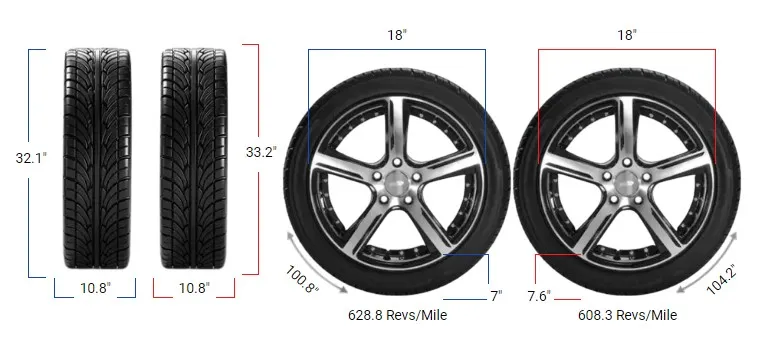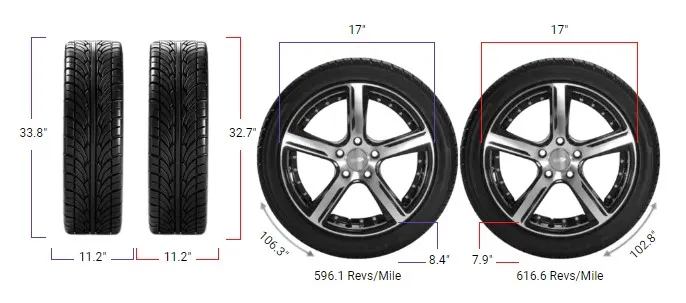Tire Size 215/65r16 vs 215/70r16
- The 3.1% overall diameter difference slightly exceeds the recommended 3% range
- Sidewall height increases by 0.42 inches (10.75 mm) or 7.7%
- Minor fitment adjustments may be necessary to avoid rubbing or clearance issues
- Slightly smoother ride due to taller sidewalls absorbing more road imperfections
- Marginally less responsive handling due to increased sidewall flex
- Speedometer may read slightly slower than actual speed
- Potential for minimal improvement in gas mileage

Fitment Guide
While the 3.1% overall diameter difference between 215/65r16 and 215/70r16 tires slightly exceeds the generally acceptable 3% range, in most cases, this interchange can still work.
However, it’s crucial to ensure that the taller tires do not cause any rubbing or clearance issues with your vehicle’s wheel wells, suspension components, or fenders.
If necessary, minor adjustments, such as realignment or slight suspension modifications, may be required to accommodate the larger tires.
On-Road Impact
Switching to 215/70r16 tires can have several effects on your on-road driving experience. Here are some potential changes you may notice:
- Ride Comfort: The taller sidewalls of the 215/70r16 tires may provide a slightly smoother and more cushioned ride, as they can absorb more road imperfections and vibrations. This can be particularly noticeable on rough or uneven road surfaces.
- Handling: Due to the increased sidewall height, the 215/70r16 tires may exhibit a bit more sidewall flex during cornering or rapid direction changes. This can result in a slightly less responsive or precise handling feel compared to the shorter 215/65r16 tires. However, for most daily driving situations, this difference may not be significant.
- Speedometer Accuracy: As the 215/70r16 tires have a larger overall diameter, your vehicle’s speedometer may read slightly slower than your actual speed. At a speedometer reading of 20 mph (32.19 km/h), your actual speed would be approximately 20.63 mph (33.2 km/h). Keep this in mind and adjust your driving accordingly.
- Gas Mileage: The taller 215/70r16 tires will rotate fewer times per mile compared to the 215/65r16 tires. This can potentially result in a slight improvement in gas mileage, as the engine will need to work a bit less to maintain the same speed. However, the actual impact on fuel efficiency may be minimal in real-world driving conditions.

Off-Road Impact
If you occasionally venture off the beaten path, switching to 215/70r16 tires can offer some advantages:
- Ground Clearance: The taller sidewalls of the 215/70r16 tires will raise your vehicle’s overall ground clearance by approximately 0.42 inches (10.75 mm). This extra clearance can be beneficial when navigating rough terrain, helping to reduce the risk of undercarriage damage from rocks, roots, or other obstacles.
- Traction: The larger tire volume of the 215/70r16 tires can provide a bit more traction in loose or slippery off-road conditions, such as mud, sand, or gravel. The taller sidewalls allow for more tire flex, which can help the tires conform to uneven surfaces and maintain better contact with the ground.
- Durability: The increased sidewall height of the 215/70r16 tires may offer slightly better protection against sidewall punctures or damage when driving off-road. The extra rubber can help absorb impacts from sharp rocks or debris, reducing the likelihood of a tire failure.
215/65r16 vs 215/70r16 Table
This table compares the 215/65R16 and 215/70R16 tire sizes with highlighting key difference.
| Feature | 215/65R16 | 215/70R16 | Difference |
|---|---|---|---|
| Diameter inches (mm) | 27 (685.9) | 27.85 (707.4) | 0.85 (21.5) +3.1% |
| Width inches (mm) | 8.46 (215) | 8.46 (215) | 0 (0) 0% |
| Circumference inches (mm) | 84.84 (2154.82) | 87.49 (2222.36) | 2.66 (67.54) +3.1% |
| Sidewall Height inches (mm) | 5.5 (139.75) | 5.93 (150.5) | 0.42 (10.75) +7.7% |
| Revolutions per mile (km) | 746.86 (464.08) | 724.16 (449.97) | -22.7 (-14.1) -3% |
| Speedo Reading | 20 mph | 20.63 mph | +0.63 mph |
What is the Difference Between 215/65r16 and 215/70r16?
The main difference between 215/65r16 and 215/70r16 tires is the sidewall height. The 215/70r16 tire has a sidewall that is 0.42 inches (10.75 mm) taller than the 215/65r16 tire, resulting in a 7.7% increase in sidewall height.
This also leads to a 3.1% difference in overall diameter, with the 215/70r16 tire being 0.85 inches (21.5 mm) taller than the 215/65r16 tire.

Can I Use 215/70r16 Instead of 215/65r16?
While the 3.1% overall diameter difference between 215/65r16 and 215/70r16 tires slightly exceeds the generally recommended ±3% range, in most cases, this interchange can still work.
However, it’s essential to ensure that the taller 215/70r16 tires do not cause any rubbing or clearance issues with your vehicle’s wheel wells, suspension components, or fenders.
Minor adjustments, such as realignment or slight suspension modifications, may be necessary to accommodate the larger tires.
How Much Taller Is a 215/70r16 Tire Than a 215/65r16?
A 215/70r16 tire is 0.85 inches (21.5 mm) taller than a 215/65r16 tire. This difference in height is due to the increased sidewall height of the 215/70r16 tire, which is 0.42 inches (10.75 mm) taller than that of the 215/65r16 tire.
The overall diameter of the 215/70r16 tire is 27.85 inches (707.4 mm), while the 215/65r16 tire has a diameter of 27 inches (685.9 mm).
Our Observation
While switching from 215/65r16 to 215/70r16 tires is possible, it’s essential to consider your specific vehicle and driving needs. The 3.1% overall diameter difference is just outside the recommended range, so ensure proper fitment and make necessary adjustments to avoid rubbing or clearance issues.
On-road, you may notice a slightly smoother ride and potentially better gas mileage, but handling responsiveness may be marginally reduced. Off-road, the taller sidewalls can provide increased ground clearance, traction, and durability.
Ultimately, the decision to switch to 215/70r16 tires depends on your priorities and driving style. If you value a more comfortable ride and occasional off-road capability, and your vehicle can accommodate the larger tires without issue, then making the switch could be a good choice.
However, if you prioritize precise handling and don’t need the extra ground clearance, sticking with the stock 215/65r16 tires may be the better option.




